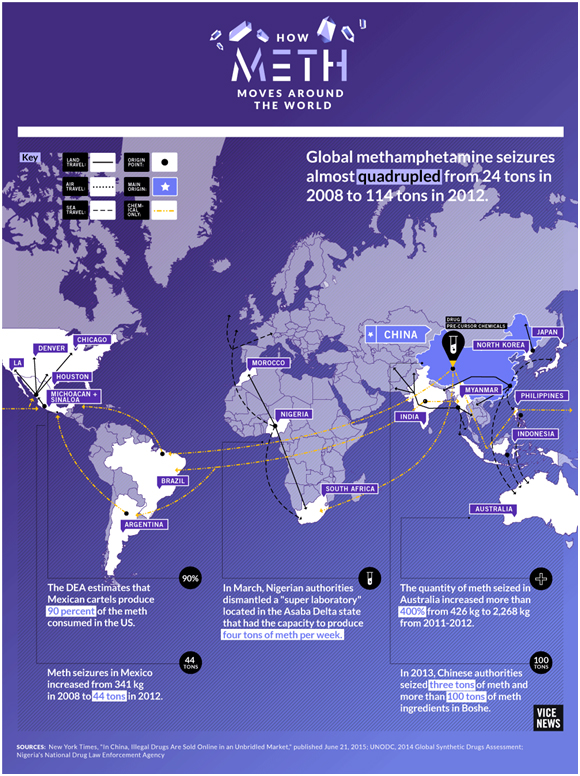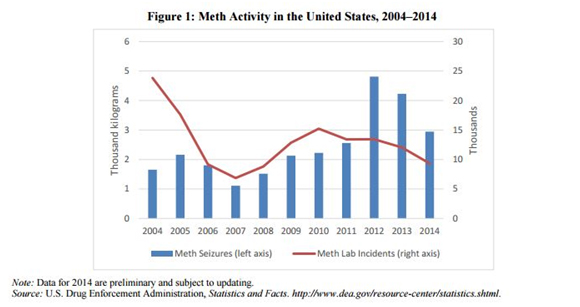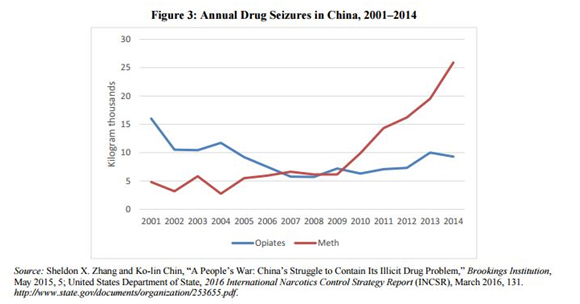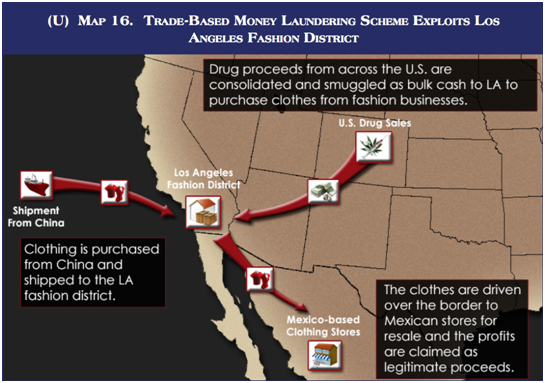Dragon on the Border: Mexican and Chinese Transnational Criminal Networks and Implications for the United States
Peter Kouretsos
Introduction
As China shifted to a hybrid capitalist system and globalized in the late 20th century, so did its criminal economy. Indeed, an overlooked but important trend has been the rise in Chinese organized crime in Latin America. While their presence is not entirely new to the region, Chinese organized crime is also a natural by-product of the increased legitimate human and commercial interactions between the two regions.[1] Narcotics and commodities smuggling, human trafficking, racketeering and extortion, and other illicit activities are all facilitated by this increased trade. Since China plans to continue deepening commercial ties with Latin America, it is possible that the increased flow of goods and people could present more opportunities for Chinese triads to expand their operations. It is abundantly clear that one country where they have such a past, present, and future in this enterprise is Mexico, and the implications are worrisome for both Mexico and her northern neighbor.[2]
Origins
Mexico’s history with China goes back much farther than most would expect. The northern city of Mexicali in Baja California was largely developed by a community of Chinese immigrants, who arrived to the area between the mid–1800s and the 1940s. Some arrived as servants to Spanish merchants, but most began arriving from Canton in the late 19th century to flee poverty. And when the US ratified the Chinese Exclusion Act in 1882, hopeful Chinese migrants tried to enter the US through Mexico illegally. In the end, most stayed, and helped build not just Baja, but also the northern states of Chihuahua, Coahuila, Sinaloa, and Sonora.[3]
The connection between the words “narcotics” and “Mexico” may have permanently coalesced when President Felipe Calderon declared the War on Drugs, but the historical destinations of Chinese immigrants are now major opium producing states. The history of Mexican heroin began with the Chinese railroad workers in Sinaloa in the late 19th century. Business boomed in the 1940s, reputedly thanks to the demands for morphine by the US Army during World War II. Today there is a new boom, driven by dependence on expensive[4] opioid medications compared to easier-to-obtain heroin.
Sin Embargoes: The Dark Side of Globalization
The post-World War II international order fostered a freer, more competitive market system which has underwritten free trade, allowed countries to address economic inequality, and has connected individuals and their ideas on an unimaginable scale. Indeed, while globalization has borne fruits, it has also inadvertently enabled the growth of transnational criminal networks (TCN) and their illicit enterprises.[5] The licit networks of global supply chains, dynamic trade patterns, and integrated markets allow illicit networks to more easily blend in, making them harder for states to detect and thwart their operations.[6] This problem is compounded in states with resource limitations, where they lack the funds and time (and often the political will) to devote to reforming their systems and taking these networks head on.
To thrive, these TCN require the coordination, manufacturing capacity, logistics, and cashflow that rival legitimate multinational corporations. Informal relationships and understandings, and mergers and acquisitions are all necessary to outmaneuver law enforcement and gain advantages relative to competitors. As the global center of gravity for economic activity shifts to the Indo-Asian Pacific, ties between Mexican and Chinese TCN have increased.
Chinese and Mexican law enforcement are familiar with the growing relationship between their respective countries’ TCN.[7] The triads have been the leading supplier of precursor chemicals to Mexican TCN for the production of methamphetamine. With one of the largest and most unregulated pharmaceutical industries in the world, Chinese authorities have essentially enabled this relationship to continue.
Methamphetamine and Fentanyl
Demand for methamphetamine has soared since the late 1990s, and the synthetic drug has become one of the most popular — and profitable — narcotics in the world (Appendix A). The quantities of meth confiscated by authorities over the past decade reflect its rise. Global meth seizures skyrocketed from 24 tons to 114 tons between 2008 and 2012. During the same period, meth seizures in Mexico rose from 341 kilograms to 44 tons, 1.5 tons to nearly 5 tons in the United States, and 6 tons to 16 tons in China (APPENDIX B).[8]
Drugs like heroin, cocaine, and marijuana are much more labor and land intensive to cultivate and process than methamphetamine. For methamphetamine, all it takes is access to precursor chemicals and amateur chemists. With most of the small meth-labs in the United States diminishing due to increased regulations on medicines like Sudafed which contain meth precursors, Mexican super-labs have filled the void, and produce 90 percent of the meth consumed in the United States. They are aided by China, which provides Mexican TCN with 80 percent of their precursor chemicals.[9]
In one case, a Chinese-Mexican businessman named Zhenli Ye Gon was arrested in 2007 after police found $205 million in cash hidden in his Mexico City home; he later admitted to selling tons of meth precursors to the Sinaloa Cartel, and the accounts investigated later revealed money laundering schemes with TCN involving HSBC and a Las Vegas casino.[10] Another TCN, the Knights Templar, sent illegally mined iron ore to China from ports in Michoacán in exchange for meth precursors.[11]
In the case fentanyl, the drug that killed Prince[12], is often counterfeited and marketed as oxycodone, Percocet, or other variants, and is 40-50 times stronger than most strains of heroin. All illicit fentanyl coming into the United States comes from China; what’s more, most of that comes through the Mexican cartels. The raw fentanyl and precursors originate in China, where they’re sent to Mexico and made into pills for distribution to the US and Canada (Appendix C). Mexican TCN are drawn to fentanyl because of low acquisition costs and the immense markup when it hits the streets. It can also be ordered in small quantities (some even in a small envelope) over the internet from Chinese manufacturers selling “research chemicals.”[13]
Money Laundering Through Trade
Cash flow is imperative in the TCN enterprise, and profits from drug sales in the United States must eventually make their way across the border, back to TCN headquarters. And since newer regulations raise alarms when large transactions, especially deposits, in Mexico are done in US dollars, the dirty money must be “washed” and converted into pesos. With Chinese businesses continuing to grow as global players, their services, willingly or unwillingly, become a viable partner to TCN.
One way TCN has accomplish its money-laundering goals has been to use loopholes in NAFTA. Mexico imposes large tariffs on many goods, but under NAFTA most are tariff-free if they come from the United States. In other words, goods from China might be cheaper, but the tariff would be prohibitively high.
However, if Mexican businesses have contacts with TCN, who have influence over Mexican customs officials, Chinese goods arriving in Los Angeles can be driven into Mexico and be labeled as a US good. The business gets cheap materials without tariffs, the TCN and corrupt officials get a cut of the profits, and the Mexican government loses valuable tax revenue. In this example, Mexican TCN can use drug proceeds in the US to purchase goods and merchandise from China, which are then resold in Mexico for pesos. (Appendix D)
Chinese manufacturers can also reap hefty profits by selling counterfeit goods such as videos, clothing, and pharmaceuticals, and TCN have aggressively moved into this market. In parts of Mexico, TCN have gone as far as placing their own logos on the merchandise they peddle, forbidding the sale by retailers of goods not bearing their logo.[14]
These practices and more reinforce an informal economy which is advantageous to TCN. Profits from the counterfeit goods acquired from their Chinese partners do not have to be integrated into the legitimate economy. Additionally, if their counterfeit, branded merchandise is less expensive than the legitimate alternatives, local consumers may be more hostile to the government when they take measures to penalize the counterfeits.
In communities where governance is weak, TCN can seize opportunities to diversify their economic activity. Hundreds of millions of dollars in goods transit the US from China and go to Mexico through fraud to facilitate trade-based money laundering, undermine Mexico’s tax base, and supply TCN with income.[15] Further, China is in effect facilitating a multibillion-dollar income stream to the Mexican TCN and absorbing billions in illicit funds from US customers of Mexican drugs, the precursors for which are supplied by China.
China is not likely to assist Mexican investigators to control TCN-Chinese related profits. Still a large export-oriented economy, the sale of goods is in China’s interest. China is under strain from the downturn in US and EU markets for Chinese exports, and its products face greater competition due to inflation and rising costs of labor, utilities, and raw materials. China produces over 2/3 of the world’s counterfeit goods, and although Beijing has officially expressed its intention to cooperate, local authorities seldom enforces the national and international statutes Beijing has signed on to.[16]
Illegal Mining
Specialization in one sector can be risky. Aside from drugs, Mexican and Chinese TCN have also diversified into mining. Indeed the Knights Templar’s iron ore scheme was not a one-off.
For example, the amber mines in Chiapas, have attracted the attention of Chinese dealers. Mining is a labor-intensive operation, but there is no problem when adults and children are abundant and willing to work for enormous sums of money. Mines there are usually rented out by their Mexican owners for months at a time to Chinese dealers, where workers can get paid $150 a day, albeit at great personal risk.[17]
Again, in the example of the Templar’s iron ore schemes in Michoacán, the Chinese were doing business with them as if they were any other company. The Mexican government has also yet to release any information about illicit mining activities tied to China. For example, the Chinese company involved in the vessel seizure filled with illegal iron ore in 2014 was not named, which stonewalled any independent investigations. Further, in the case of Michoacán, no Chinese companies registered with the Mexican Mining Chamber mention having business there.[18]
Migration and Human Trafficking
The most politically visible issue between the US and Mexico is their shared 3,145-kilometer border, and the debate about migration across it rarely includes the subject of China. China has become the leading source of immigrants worldwide, and the United States is an increasingly popular destination. Of the roughly 11 million unauthorized persons in the United States, approximately 268,000 of those are Chinese, making China the fifth largest ethnic group of undocumented migrants in the US.[19] Most fly from mainland China and overstay their visas, but there has been an uptick in the number of Chinese smuggled across the southern border. For example, in 2016 in San Diego 663 migrants from China were stopped trying to cross the border, a 1,281 percent increase from 2015.[20]
Human smuggling and trafficking from China to the United States is certainly not new, and it has waxed and waned over several decades.[21] As early as the 1990s there began a recognition of the connection between Chinese and Latin American TCN.[22] Just as with narcotics and other contraband, the human smuggling across the border has continued.
Though small in overall numbers, enormous profits can be made by TCN in smuggling Chinese across the US – Mexico border. Smuggling a Central or South American can certainly be expensive, with the added distance from China and added risk, smugglers can command steeper prices. The going rate for a Chinese smuggling operation across the border can be anywhere from $50,000 - $70,000 per person, and with each TCN from China to Mexico taking a cut, there is plenty of money to be made for everyone.[23]
Implications
Chinese triads have deepened their ties with Latin American TCN, and in this case Mexico, over many years. This partnership, be it an alliance or an understanding, includes not just smuggling, but also other illicit activities such as the sale of drug precursors from Asia and counterfeit goods and merchandise. In Mexico, contact between triads and Mexican TCN occurs in various regions. The various smuggling routes controlled by rival Mexican TCN has required Chinese triads to form relationships with several different groups, such as Sinaloa, Los Zetas, and Knights Templar. It is unclear whether the Chinese will heavily back one group over another, but the triads are not a monolith either, as they have independent interests too.
The diversification of Chinese and Mexican TCN businesses has required law enforcement in China, Mexico, and the US to think about more than just their individual borders and jurisdictions. Ultimately, addressing the challenge of Chinese and Mexican TCN requires the United States, China, and Mexico, to work together. The United States and China already formed relationships in the 1990s to address drugs and illegal immigration, but more commitments to expand and strengthen law enforcement cooperation would be a welcome next step.[24] In the case of Mexico, economic and political ties with China have expanded over the past decade[25], and a natural follow-on to this ought to be increased security cooperation. However, with the United States wary of too much extra-hemispheric influence by other countries in Latin America,[26] an institution for trilateral law enforcement cooperation could smoothen any pushback from Washington. Indeed, since the threat posed by TCN affects all countries involved, it requires collaboration and cooperation by all countries involved.
Appendix A

Appendix B

*Per more recent data, meth trafficking to the US spiked again in 2015[27]

Appendix C

Appendix D

End Notes
[1] Zhang, Sheldon X. and Ko-lin Chin (2002). The Social Organization of Chinese Human Smuggling-A Cross National Study. San Diego, CA: San Diego State University. https://www.ncjrs.gov/pdffiles1/nij/grants/200607.pdf
[2] David Gagne, “Rising Dragon? The Chinese Mafia Threat in Latin America” Insight Crime. 15 October, 2014. Accessed 20 February 2017. http://www.insightcrime.org/news-analysis/rising-dragon-the-chinese-mafia-threat-in-latin-america.
[3] Robert Chao Romero, The Chinese in Mexico, 1882-1940. Tucson, University of Arizona Press, 2010.
[4] Prescription opioids used to treat severe pain in the United States cost upwards of $100, though the average is between $400-$500. Additionally, it is difficult to get the prescription itself, since they are highly addictive. Meanwhile, no prescription is needed for heroin, where the street price for a gram is between $100-$200. Prices for Popular Opioids. GoodRX. https://www.goodrx.com/opioids.
[5] Storti, C. & De Grauwe, P. (2009). Globalization and the price decline of illicit drugs. International Journal of Drug Policy, 20(1), 48-61. United Nations Office of Drugs and Crime, 2015. World Drug Report 2015. New York, New York: United Nations.
[6] Serrano, M. “Transnational organized crime and international security: Business as usual?” Chapter in Transnational Organized Crime and International Security: Business as Usual? Berdal and Serrano, eds. 13-35. Boulder: Lynne Reinner Publishers, 2002.
[7] R. Evan Ellis, “Chinese Organized Crime in Latin. America,” Prism, Vol. 4, No. 1, December 1, 2012, pp. 67-77.
[8] Recent Statistics and Trend Analysis of the Illicit Drug Market. UNDOC. 2014. https://www.unodc.org/documents/wdr2014/ATS_NPS_2014_web.pdf
[9] U.S. – China Economic and Security Review Commission, Sean O’Connor, Staff Research Report. Meth Precursor Chemicals from China: Implications for the United States. July 18, 2016. http://origin.www.uscc.gov/sites/default/files/Research/Staff%20Report_PrecursorChemicalReport%20071816_0.pdf.
[10] Joel Schectman and Mica Rosenberg, “Reuters Exclusive: Chinese-Mexican man at center of $205 million seizure could be extradited to Mexico in days – lawyer.” August 25, 2016. http://www.reuters.com/article/us-usa-mexico-extradition-idUSKCN1102CC.
[11] The Economist. “Why Mexican drug-traffickers started smuggling iron ore to China.” March 9, 2014. http://www.economist.com/blogs/economist-explains/2014/03/economist-explains-4.
[12] Alex Johnson, “What Is Fentanyl? The Drug That Killed Prince Has Killed Thousands of Others.” NBC News. June 3, 2016. http://www.nbcnews.com/news/us-news/what-fentanyl-drug-killed-prince-has-killed-thousands-others-n584961.
[13] Dan Levin, “In China, Illegal Drugs Are Sold Online in an Unbridled Market” The New York Times. June 21, 2015. https://www.nytimes.com/2015/06/22/world/asia/in-china-illegal-drugs-are-sold-online-in-an-unbridled-market.html
[14] Patrick Manning “Drug Cartels Take Over Mexican Black Market” Fox News. August 22, 2012. http://www.foxnews.com/world/2012/08/22/drug-cartels-take-over-mexican-black-market.html.
[15] Tracy Wilkinson and Ken Ellingwood “Cartels use legitimate trade to launder money, U.S., Mexico say” The Los Angeles Times. December 19, 2011. http://articles.latimes.com/2011/dec/19/world/la-fg-mexico-money-laundering-trade-20111219
[16] David Volodzko “China's Addiction to Counterfeiting” The Diplomat, October 17, 2015. http://thediplomat.com/2015/10/chinas-addiction-to-counterfeiting/.
[17] Sin Embargo “Bandas chinas explotan niños por el ámbar de Simojovel, pueblo olvidado de Chiapas” 18 May 2015 http://www.sinembargo.mx/18-05-2015/1345183
[18] Laurence Cuvillier “How Chinese Mining Companies Sustain Organized Crime in Mexico.” VICE News, June 25, 2014. https://news.vice.com/article/how-chinese-mining-companies-sustain-organized-crime-in-mexico.
[19] Migration Policy Institute. Profile of the Unauthorized Population United States. http://www.migrationpolicy.org/data/unauthorized-immigrant-population/state/US.
[20] South China Morning Post “Illegal Chinese immigrants are flocking to San Diego, smuggled over the border with Mexico,”June 8, 2016. http://www.scmp.com/news/world/united-states-canada/article/1968984/illegal-chinese-immigrants-are-flocking-san-diego.
[21] Zhang, Sheldon X. and Ko-lin Chin (2002). The Social Organization of Chinese Human Smuggling-A Cross National Study. San Diego, CA: San Diego State University. https://www.ncjrs.gov/pdffiles1/nij/grants/200607.pdf
[22] Sebastian Rotella and Lee Romney, “Smugglers Use Mexico as Gateway for Chinese Immigration: The increasing influx of illegal immigrants is largely because of an alliance between Latin American and Asian crime syndicates, INS authorities say.” The Los Angeles Times. June 21, 1993. http://articles.latimes.com/1993-06-21/news/mn-5468_1_illegal-immigrants.
[23] South China Morning Post “Illegal Chinese immigrants are flocking to San Diego, smuggled over the border with Mexico,”June 8, 2016. http://www.scmp.com/news/world/united-states-canada/article/1968984/illegal-chinese-immigrants-are-flocking-san-diego.
[24] Xinhua, “China, US to discuss law enforcement cooperation.” November 16, 2016. http://english.gov.cn/news/international_exchanges/2016/11/16/content_281475492603192.htm
[25] Ana Campoy “Trump isn’t even president yet and China is already moving in on Mexico.” Quartz. December 7, 2016. https://qz.com/855355/china-and-mexico-are-strengthening-commercial-and-diplomatic-ties-in-response-to-donald-trumps-protectionism/
[26] Gary Regenstreif “The looming U.S.-China rivalry over Latin America.” Reuters, June 12, 2013. http://blogs.reuters.com/great-debate/2013/06/12/the-looming-u-s-china-rivalry-over-latin-america/.

